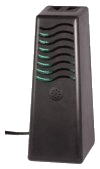Newly Discovered Air Pollutants Damage Lungs Like Cigarette Smoke:
What Can You Do?
by www.SixWise.com
It’s long been a mystery why so many non-smokers develop “smoker’s diseases” like lung cancer. Now that mystery may have been solved, thanks to research by Louisiana State University in Baton Rouge scientists.
|

The average person is exposed to 300 times more free radicals a day from breathing PFRs than from smoking one cigarette, researchers found.
|
H. Barry Dellinger, Ph.D., the Patrick F. Taylor Chair of Environmental Chemistry at Louisiana State University in Baton Rouge, and colleagues detected a new type of air pollutant they call persistent free radicals (PFRs). While it’s long been known that free radicals, molecules that are highly damaging to cells in your body, exist in the atmosphere, most of them only exist for less than a second, then disappear.
PFRs, on the other hand, linger in the air and can travel over great distances. They form on airborne nanoparticles and other fine particle residues as gasses from smokestacks, exhaust pipes and household chimneys cool. What makes these particles unique, and especially dangerous, is the fact that they could have effects similar to those caused by tobacco smoke.
"Free radicals from tobacco smoke have long been suspected of having extremely harmful effects on the body," Dellinger said on Physorg.com. "Based on our work, we now know that free radicals similar to those in cigarettes are also found in airborne fine particles and potentially can cause many of the same life-threatening conditions. This is a staggering, but not unbelievable result, when one considers all of diseases in the world that cannot currently be attributed to a specific origin."
When PFRs are inhaled, it’s thought that they are absorbed into the lungs and other tissues, causing DNA and cellular damage.
How Widespread is Air Pollution in the United States?
Sadly, air pollution is now a widespread problem in the United States. It comes from multiple sources -- factories, power plants, dry cleaners, cars and trucks, wildfires and even from materials in your home.
Two out of every five people, or 42 percent of the U.S. population, actually live in counties that have unhealthful levels of ozone or particle pollution -- two types of air pollution -- according to the American Lung Association's State of the Air 2008.
You can check the daily air quality in your area at AirNow.gov, the most polluted cities that have year-round particle pollution (the most dangerous of the widespread outdoor air pollutants) are:
- Los Angeles, CA
- Bakersfield, CA
- Visalia, CA
- Houston, TX
- Fresno, CA
- Sacramento, CA
- Dallas, TX
- New York City, NY
- Washington D.C./Baltimore, MD
- Baton Rouge
The air inside of your home may actually be an even bigger threat to your health than outdoor air. According to the U.S. Environmental Protection Agency (EPA):
"In the last several years, a growing body of scientific evidence has indicated that the air within homes and other buildings can be more seriously polluted than the outdoor air in even the largest and most industrialized cities.
Other research indicates that people spend approximately 90 percent of their time indoors. Thus, for many people, the risks to health may be greater due to exposure to air pollution indoors than outdoors."
Air Pollution is a Major Public Health Threat
|

Since cigarette smoke also contains PFRs, smokers get a double dose of the toxic particles -- from both the surrounding air and the smoke itself -- every time they light up.
|
When you breathe in polluted air, the pollutants reach much further than your nose, mouth and even lungs. Polluted air affects all of your body's systems, particularly your respiratory and cardiovascular systems.
Think of it this way: your lungs are designed to transport oxygen you breathe in into your bloodstream, where it's carried throughout your entire body. Whatever is in that air, then, is also eventually transported, via your bloodstream, to all the organs in your body, including your heart, liver, brain and other organs.
Along with the 16 health problems, including genetic abnormalities, that were discussed in a past Sixwise.com article, a study published by the published by the Karolinska Institute, Institute of Environmental Medicine, found that long-term exposure to air pollution, particularly that from motor traffic, increases the risk of fatal heart attacks.
Another study, published in the March 2005 issue of Occupational and Environmental Medicine, found that air pollution increases the risk of heart attacks and strokes, and makes respiratory problems worse, by thickening the blood and increasing inflammation, respectively.
In all, about 4 percent of deaths in the United States can be attributed to air pollution, according to the Environmental Science Engineering Program at the Harvard School of Public Health.
|
Purify Your Air, Fast, With PIONAIR
With the PIONAIR Air Treatment System you can remove smoke, dust pet dander, mold, bacteria, pollen and more from your home and office air so you can breathe freely.
 All PIONAIR Systems include a 30-Day Money-Back Guarantee! All PIONAIR Systems include a 30-Day Money-Back Guarantee!
And for a LIMITED TIME ONLY, Get $30 Off Each PIONAIR Air Treatment Unit, Plus FREE SHIPPING and a FREE MiniMate Refrigerator Unit!
Choose Your PIONAIR
System and Order Now!
|
What You Can do to Protect Your Health
Your exposure to air pollution outdoors is largely out of your control (unless you can relocate to an isolated island in some pristine locale), but there are some steps you can take to minimize your risks. You can also take steps to improve the quality of your indoor air and, therefore, your long-term health as well. Here are the top tips.
- Purify your indoor air. The PIONAIR Air Treatment System, which Sixwise.com highly recommends, uses photocatalysis, which is designed to oxidize organic odors, germs, and fungi. The PIONAIR technology creates ultraviolet light rays, safe levels of ozone, and passive negative ions as part of your air treatment. This is not just any old air filter -- it is an air purifier that duplicates Nature's own methods of air cleaning and revitalization.
- When pollution is heavy, be sure to drink plenty of fluids (non-alcoholic) to keep your respiratory tract moist.
- Avoid high levels of smog and pollution. These are typically highest during the midday and afternoon. If you're in a high-risk group, don't go outside when ozone levels are high.
- Exercise when the air is cleaner. When you exercise (or work strenuously), you draw air more deeply into your lungs, and therefore risk more damage from air pollution. To protect yourself and get the numerous health benefits of exercise, avoid exercising near congested streets and during rush-hour traffic, and definitely if there's a wildfire burning in your area.
- Keep dirt and dust out of your home. A few high-quality mats, like the Waterhog Grand Premier Mats, placed strategically around your home (such as in doorways and other highly trafficked areas), will go a long way toward reducing the amount of dirt and dust in your home in the first place. Once inside, that dirt gets circulated into the air and you breathe it in.
This is also precisely why cleaning your home properly to remove excess dust and dirt is so important to your air quality. However, if you use ordinary rags or mops, you will simply push dirt from one area to another -- NOT pick it up and eliminate it like you intended. That's why we recommend PerfectClean mops, cloths and dusters to give your home a microscopic level of clean. Every item is built with PerfectClean's revolutionary ultramicrofiber construction that enables them to reach deep into microscopic crevices (NO other cleaning tool available even comes close!) and remove everything in their path: all forms of dirt, dust, hair, dander, and the biological contaminants too small to see with the naked eye.
While you can’t realistically remove every impurity from your family’s air, these steps will keep the air you breathe as clean and toxin-free as possible.
Recommended Reading
Are You Getting Enough Fresh Air? Important Insights You Need to Know
How Typical Roadside Dirt Can Pose Serious Health Risks to You
Sources
Physorg.com August 17, 2008
American Lung Association State of the Air 2008
The Karolinska Institute
Occupational and Environmental Medicine March 2005; 62(3):164-71